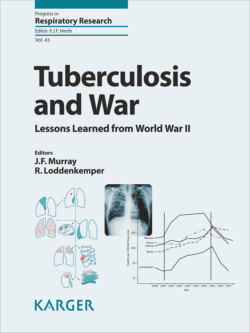Читать книгу Tuberculosis and War - Группа авторов - Страница 57
На сайте Литреса книга снята с продажи.
Human Immunodeficiency Virus
ОглавлениеHuman immunodeficiency virus (HIV) was not yet known during WWII, but the link between TB and HIV is now well established: “The risk of active TB doubles in the first year of HIV co-infection, and the risk of developing active disease in those who have LTBI is on average 10% per year in the course of an untreated HIV infection, HIV-TB co-infected individuals have reduced survival and are at higher risk for subsequent opportunistic infections. In overcrowded and poor living conditions, the combined effect of the 2 epidemics is magnified” [34], and, thus, HIV could have a major impact on the TB epidemiology in current and future wars. This is confirmed in the comprehensive review of Kimbrough and associates on the burden of TB in crisis-affected populations, where the risk of excess mortality among HIV-positive individuals was substantially enlarged [6]. However, most of the studies were done before the era of widespread access to antiretroviral medicines that most likely will reduce the excess risk due to HIV in ongoing and forth coming crises.
The World Health Organization (WHO) postulates that more resources should be directed to screening, diagnosis, and treatment of HIV and TB drug resistance, monitoring early indicators of resistance and integrating HIV and TB prevention and intervention [43]. Kerridge et al. [44] regard these recommendations as even more critical in conflict-affected states with weakened public health infrastructure in which antiretroviral therapy programs can be destabilized, and treatment and supply chains interrupted.
